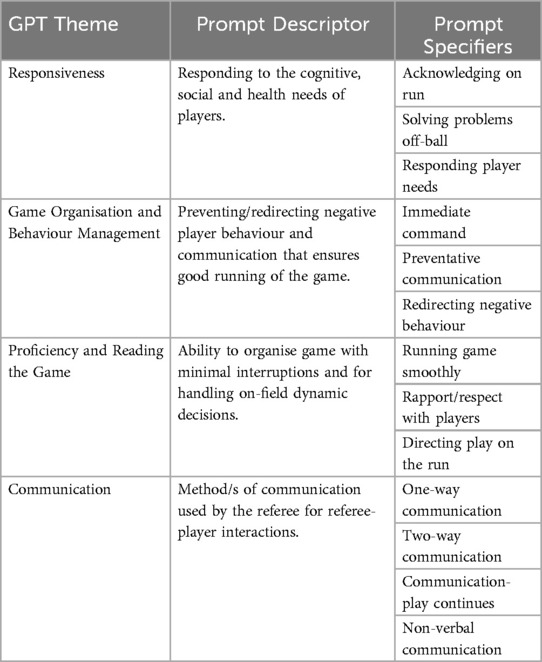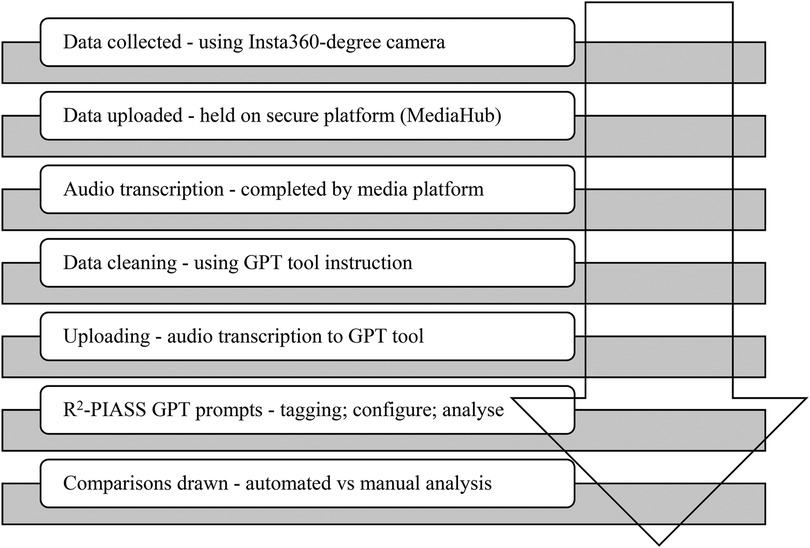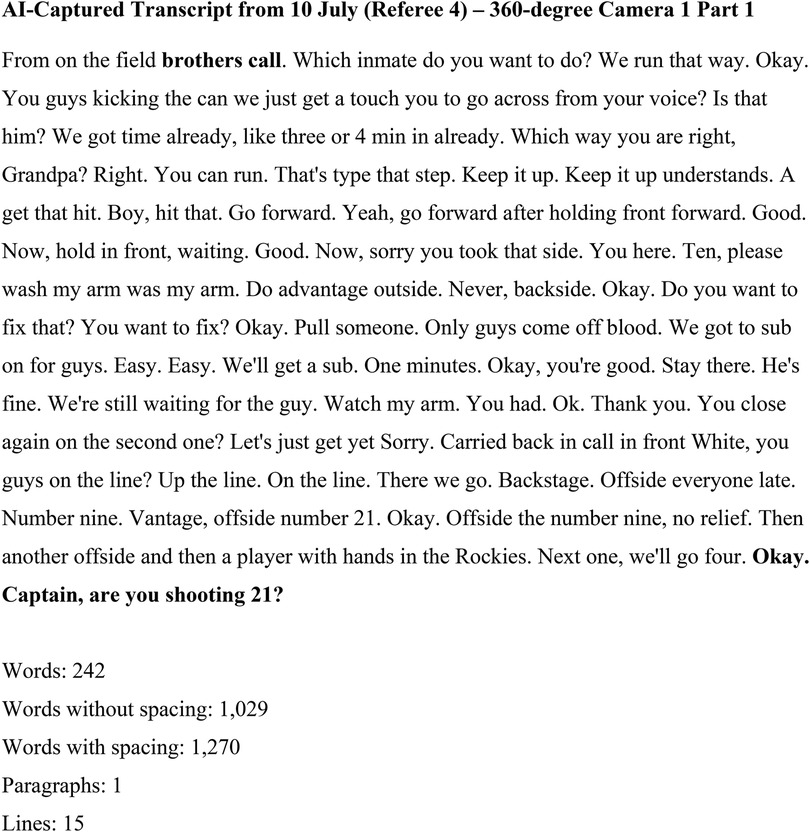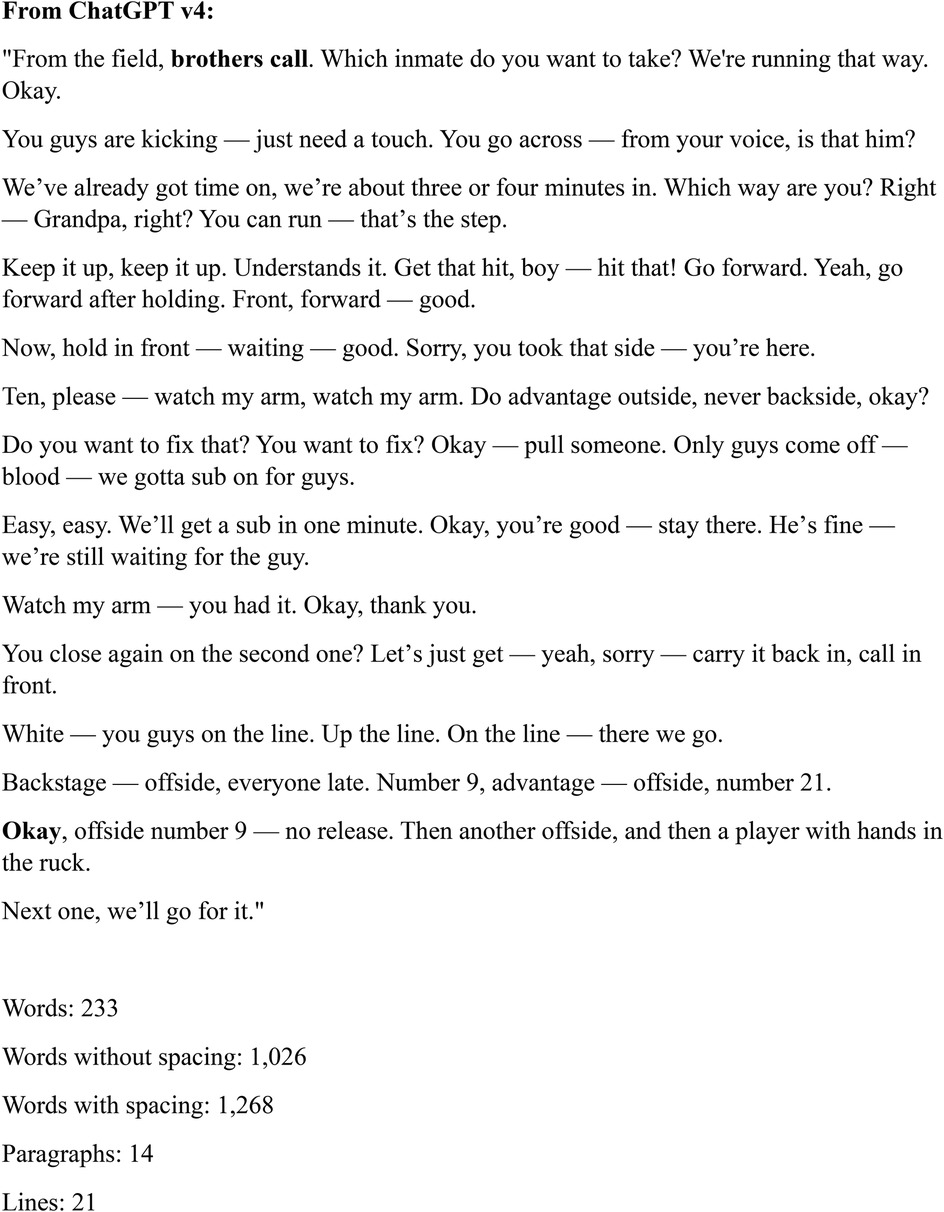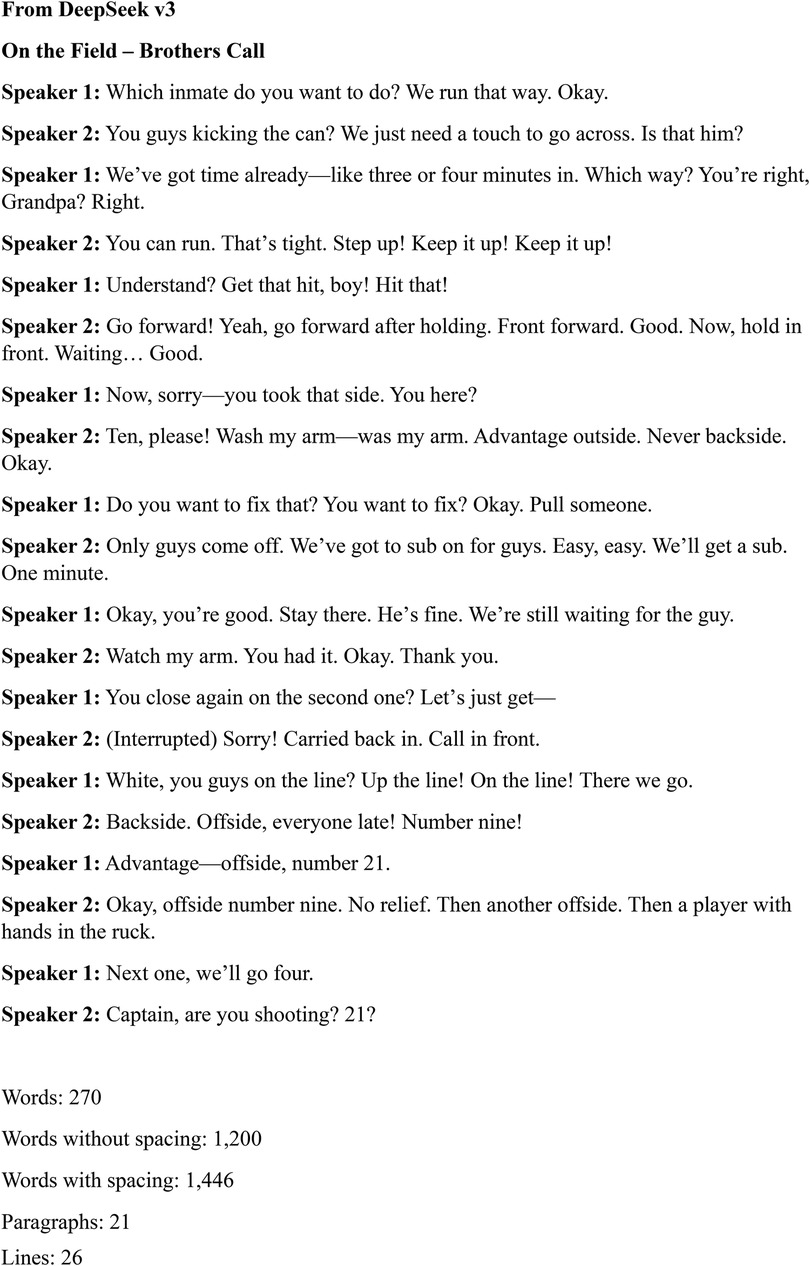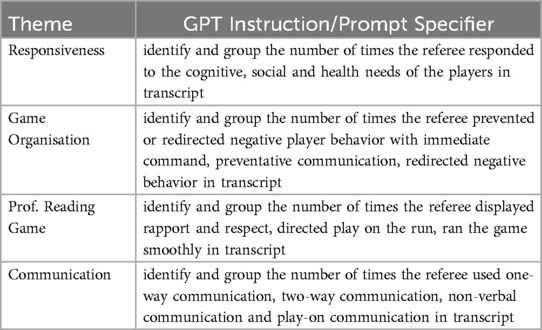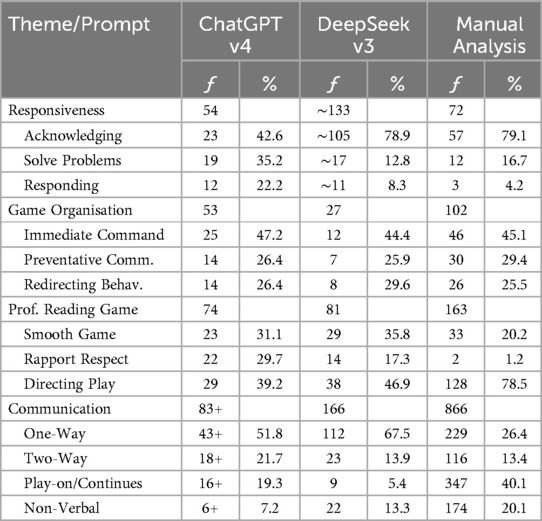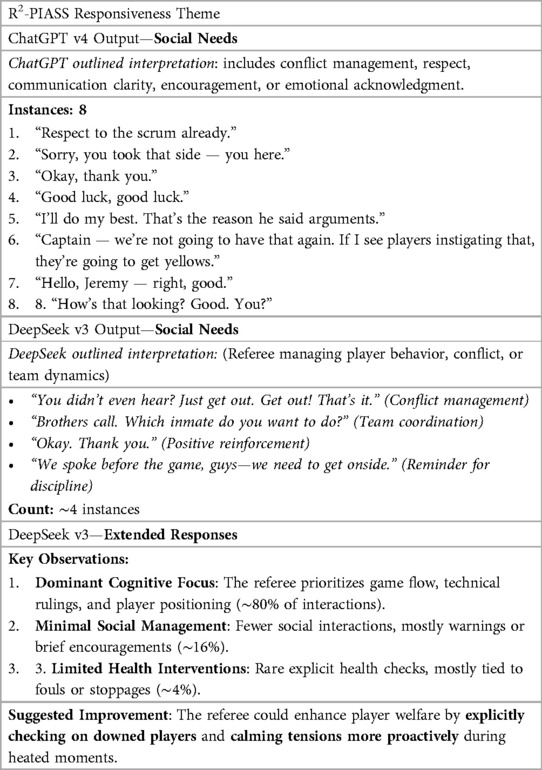- School of Exercise and Nutrition Sciences, Queensland University of Technology, Brisbane, QLD, Australia
This study represents one of the initial efforts to analyse a coach-athlete conversational dataset using freely available GPT tools and a pre-determined, context-specific, prompt-based analyses framework (i.e., R2-PIASS). One dialogue dataset was selected by means of two different freely available AI-based GPT tools: ChatGPT v4 and DeepSeek v3. The results illustrated that both ChatGPT v4 and DeepSeek v3 models could extract quantitative and qualitative conversational information from the source material using simple R2-PIASS prompt specifiers. Implications for how coaches can use this technology to support their own learning, practice designs, and performance analyses were the efficiencies both platforms provided in relation to cost, usability, accessibility and convenience. Despite the strengths, there were also associated risks and pitfalls when using this process such as the strength and robustness of the applicable statistical outcomes and tensions between keeping the input data within the context and ensuring that the context did not breach privacy issues. Further investigations that engage GPT platforms for coach-athlete dialogue analysis are therefore required to ascertain the true relevance and potential of using this type of technology to enhance coach learning and athlete development.
1 Introduction
For decades, sports coaching has used technology such as video feedback (VF) to enable observations of performance multiple times. Advanced technologies in wearable sensors to monitor and evaluate physiological biomarkers combined with the use of computer-assisted analysis have also provided sport coaches with cutting-edge insights and the quantification of performance data without direct proximity to athlete practice and performance sessions (1–3). Moreover, recent developments in Artificial Intelligence (AI) technologies now allow sport coaches the chance to review key movement moments alongside quantitative data in real time, providing much faster insights into their athletes' performance results (4). However, while athlete monitoring tools and analysis software are widely seen as standard for shaping athlete development processes, understanding the degree to which the automated collection of data using AI-based algorithms and associated tools can support sport coaches with their professional practice and own learning is not well understood (4, 5). Indeed, few studies have been conducted to determine whether sport coaches are willing to integrate AI-based Generative Pretrained Transformer (GPT) tools into activities that support their practice processes, formal and informal learning, developmental experiences, and self-analyses of their own work. Yet, if we accept that a consistent factor in athlete and team success is the contribution of the coach, positioning how advanced AI-based GPT tools such as Microsoft Copilot, Google Bard, Claude or ChatGPT can support and shape coaching knowledge and processes related to practice design is important (6–8).
The purpose of this project is aligned with assessing the functionality of freely available AI-based GPT tools such as DeepSeek and ChatGPT for sport coach development. Development, in this case, represents the process of a person (i.e., sport officiating coach) seeking to deliberately become a better version of themselves through the incorporation of a digital technology that identifies and analyses human-like language (8, 9). Leveraging how smart language tools can assist with identifying and signposting processes related to human language analysis, such as the diagnosis and delivery of performance feedback, is valuable for understanding whether AI-based GPT tools can support sport coaches with their own learning and athlete development. Moreover, we ask, can ChatGPT, Copilot, Bard and other freely available AI-assisted GPT applications become part of a sport coaches toolkit to be embedded in, replace and/or augment many of the tasks related to the diagnosis and delivery of performance feedback connected to coach-athlete dialogue. For example, data platforms powered by AI analyses and conversational systems based on Large Language Models (LLMs) such as ChatGPT potentially offer online, scalable systems for delivering tailored team- and athlete-based performance feedback (6, 10, 11). Beyond athletes, AI-based GPT tools also hold promise for transforming coaching practices and subsequent learning in areas related to quantifying coach-athlete spoken parameters. General AI platforms that utilise Natural Language Processing (NLP) for instance offer the capacity to statistically analyze language structures, allowing sport coaches to examine the complete meaning of text or speech, including intent and emotions (12). Thus, while the concept of applying AI-based GPT tools to support coach learning and performance analyses might be a fairly recent phenomenon, AI-based GPT tools that act as language interpreters within LLMs have been in existence for several years [see (13)], suggesting that these applications and digital tools might provide an alternative pathway for advancing sport coach learning and athlete development in the conversational analysis field (11, 14).
The aim of this paper is to explore whether freely available AI-based GPT tools can be used to tag, configure, and analyze audio data for the purpose of completing a conversational-based performance assessment. Specifically, conversations between sport referees and players on-field will provide the audio data. Like coach-athlete conversations, referee-player dialogue involves not only the exchange of information but also complex relational and interactive processes that involve negotiated meanings and the building of relationships. To offer a systematic and transparent approach to evaluating whether an AI-based GPT tool can effectively signpost conversational performance parameters, we previously developed and published a novel, prompt-based conversational agent termed the Rugby–Referee–Players' Interaction Assessment Scoring System (R2-PIASS) for evaluating referee-player dialogue (O'Brien et al., 2025 under review). The framework was initially developed from empirical research on the role of the referee in youth sport and teacher-student interactions [see (15)], and then modified to create a sport specific tool for supporting rugby union referee match coaches with completing referee performance assessments. Thus, while the R2-PIASS was designed for examining the network of speech acts that contribute to rugby referees transferring and responding to information about events taking place on field or having taken place (16, 17); (O'Brien et al., 2025), its fundamental design was underpinned by a gap in the research; that is, understanding whether tailored GPT prompts can be leveraged to support sport coaches with refining their coach-athlete feedback related to athlete performance and evaluations of their own practice processes. As such, this study deliberately sought to assess the quality of referee (as the coach)-player conversations by incorporating the R2-PIASS parameters as input prompts into freely available AI-based GPT tools. The objective is to evaluate the GPT's ability to structure its responses, essentially using the parameters to act as a customised blueprint for guiding the feedback outputs and practice process suggestions related to coach-player dialogue measures.
2 Ethical considerations
This study was approved by the Human Research Ethics Committee of The Queensland University of Technology [QUT] (Ethics: #7278). Informed consent was obtained from all participants before recording their games using an Insta 360-degree video camera. Participants did not receive any monetary compensation for being part of the study and the authors report there are no competing interests to declare. No identifiable or sensitive player information was uploaded into the freely available AI-based GPT tools.
3 Materials and methods
The Design Science Research (DSR) paradigm framed the underlying assumptions, beliefs, and approaches used to explore and analyze the conversational data. While DSR is primarily used in the Information Systems (IS) space, it also underscores how to address real-world problems. For example, rather than simply observing and theoretically explaining existing phenomena, the paradigm aims to understand and validate subjective meanings through information or collected data within specific contexts such as coach learning, performance settings, or athlete development (18). This meant that a strong emphasis was placed on using a verified prototype framework (i.e., R2-PIASS framework) to act as the conversational agent, not limiting the inputs into the AI-based GPT tools but rather making it easier to assess whether the framework prompts channelled the users' interest towards the pre-determined goal of enhancing coach learning, feedback information, and eventually athlete development (12, 13). As shown in Table 1, the R2-PIASS framework provided contextually relevant input themes for analyzing the conversational exchanges between semi-professional rugby union referees (representing sport coaches) and on-field players in the sport of Rugby Union.
3.1 Participants
There was a purposive effort (see 44) to recruit participants who were actively refereeing Rugby Union at the semi-professional level. Referees at this level of experience were known to acknowledge the importance of communicating effectively and to be able to deal with the constant accountability of performing their role (19). It is also well known that sport referees communicate more frequently than sport coaches during games, using their voices to make calls, explain decisions, and give clear instructions to players (20). Thus, sport referees were seen as a suitable metaphor for this study as they provide a substantial volume of sport-based conversational data over one game. Study participants therefore needed to be experienced in overseeing the sport of rugby union (over 6+ years active refereeing) and operating in the state-wide Division 1 Competition. Five referees provided written consent for their games to be video recorded using an Insta 360-degree camera. Based on wanting to explore whether AI-based GPT tools can be used to tag, configure, and analyze audio data for conversational performance assessments and the small number of study participants, limited personal information was collected about each referee to reduce the likelihood of a referee's identity being revealed during the research and publication processes.
3.2 Data collection
Data collection involved storing an audio and visual recording of each referee's game captured from a single head-mounted Insta 360-degree video camera. This recording was made continuously from the pre-match locker room, after the match referee warmed up, until the referee returned to the locker room at half time, when the camera was exchanged for another identical camera by the lead researcher to ensure sufficient battery life until the end of the match. Five Division 1 games, at five different venues, were recorded using this procedure. Unlike previous research using 360-degree video [see (21)], the Insta 360-degree camera automatically stitches images and audio together without the need to join or synchronize two 180-degree video shots together. This automated process made it possible to perform 360-degree visual scans in all directions from a single camera source to examine both the visual and audio data, including isolating the conversational dialogue occurring between the referee and players on-field.
3.3 Data analysis
The primary goal of this study was to explore whether freely available AI-based GPT tools can be used to tag, configure, and analyze audio data for the purpose of completing a conversational-based performance assessment. To analyze the data, we chose to employ an AI augmented thematic analysis process based on the R2-PIASS framework prompts [see (12, 22)]. Prompts, in AI augmented analyses, have much in common with the identification of specific features or aspects of the data that seem relevant to the research question and research context (23). Thus, rather than using an open-inductive process, patterns and relationships within the conversational data were identified using a pre-determined coding framework for the GPT prompts, purposely designed to support the analysis of rugby referee-player dialogue. Moreover, while the conversational nature of freely available AI-based GPT tools makes them an accessible interface that requires no special training or skills, the construction of precise prompting terms is known to improve the accuracy of data analysis, including the return of contextually relevant information more efficiently (12, 24).
One referee dataset was selected for analysis by means of two different freely available AI-based GPT tools: ChatGPT v4 and DeepSeek v3. ChatGPT is one of the most popular AI-based GPT sources available, having significantly more users, website traffic and overall brand recognition, making it an ideal “freely available” model for analysing the referee-player dialogue (25). DeepSeek was chosen for its ability to generate fast information with customized outputs, which can potentially improve the accuracy of answers related to LLM analyses (25). Once the GPT prompts tag, configure and analyze the audio data, the automated output results were compared with a manual content analysis of the same referee audio dataset using the same R2-PIASS prompts. Notably, the importance of dataset selection in LLM research cannot be overstated (26). While statistical analysis places importance on large-scale datasets at the centre of model design, development and evaluation, the enormous scale of such datasets has often been widely mythologized as beneficial to the perceived generality of trained systems (26, 27). In this project, dataset selection was therefore seen as a key issue that required careful consideration to ensure that the output parameters were robust and directly applicable to coach learning and athlete development applications.
Recent work by Schlangen (28), noted that datasets that map directly to a use case (e.g., automatic transcription of audio data) are suitable benchmarks “if the task is well-aligned with its real-world use case and the dataset is sufficiently representative of the data the systems would encounter in production” (p. 2). Moreover, recent work in NLP has revealed how single baseline datasets can be robust for LLM research and that models trained on incomplete inputs still perform quite well (26, 27). Considering this and based on concerns that data uploaded to freely available AI-based GPT tools is available in the public domain, this project purposively selected one audio dataset for conversational analysis. Rather than adopting the common practice of “if it is available to us, we ingest it” [see (29)], as is typical in other AI-driven, data-centric processing disciplines, we carefully selected a sufficiently representative dataset for analysis. In other words, rather than focusing on the statistical properties of datasets as a site for trying to address and mitigate bias or fabricated/hallucinated data, we intentionally chose to mitigate the impacts of noise in the input data as our simple language task is aimed at framing an input space (i.e., R2-PIASS prompts) and an output or action space (i.e., comparing manual and GPT tools) for an applied outcome (28). We further highlight that human judgment on natural language reasoning tasks is variable and our GPT evaluations of this task (i.e., ChatGPT v4 and DeepSeek v3) should reflect both this variability and risks of reusing data outcomes out of context (27, 28). Figure 1 outlines the procedural steps involved in the project's data analysis.
4 Results
The results of the study are organised into two parts. The first section compares the results of an unedited referee conversational extract captured from the Insta 360-degree video camera with an AI-cleaned data extract sourced from the same video extract using ChatGPT v4 and DeepSeek v3. The second section compares the frequency of prompt occurrences between the R2-PIASS manual content analysis and automated ChatGPT v4 and DeepSeek v3 R2-PIASS content analyses.
4.1 Conversational transcript comparisons
Figure 2 displays an extract of Referee 4's unedited audio captured automatically from the Insta 360-degree video camera for the 10 July game. The storage platform, MediaHub, a secure video platform for university staff that avoids the risks of placing content on public distribution platforms, uses Automatic Speech Recognition (ASR) technology to instantly generate a printable transcript by converting spoken words into text. The MediaHub extract provided illustrates how the raw referee conversational data required extensive cleaning by either manual or automated process prior to uploading into a GPT tool for analysis.
Figures 3, 4 represent “cleaned” referee-player transcripts sourced from the same audio extract. To clean the MediaHub transcription, we entered the command “Clean this transcription:” into both freely available AI-based GPT tools followed by the full text of the unclean transcription (30). The final cleaned transcripts were reviewed only by AI. For comparison, the Review feature in word was used to calculate the number of words, words without spacing, words with spacing, number of paragraphs and number of lines in both GPT “cleaned” transcription extracts.
4.2 Analyzed audio data sourced using the R2-PIASS GPT prompts
Well considered prompts can generate GPT sourced summaries to a specified level of detail (12). For this project, numerical comparisons were drawn between a manual content analysis and ChatGPT v4 and DeepSeek v3 R2-PIASS content analyses of one referee dataset. Four GPT sentence prompts were designed to capture data about the R2-PIASS themes of Responsiveness; Game organisation and Behaviour Management; Proficiency and Reading the Game; and Communication. Sentence prompts were purposively kept simple and designed to closely align with the prompt specifiers outlined in the R2-PIASS framework. Table 2 outlines the sentence prompts used. While the cleaned source material could be reformatted into two separate transcripts to reflect each half of a game, in this project, the material was uploaded as one word file. Once uploaded, coding immediately began.
Table 3 displays comparisons between the frequency and percentage of responses from the ChatGPT v4 and DeepSeek v3 R2-PIASS content analysis and manual R2-PIASS content analysis. Frequency represents the number of times a specific R2-PIASS framework prompt specifier appeared in the audio transcript. For example, there were 116 instances of two-way communication between the referee and player/s on field manually identified, compared with 18+ instances by ChatGPT and 23 instances by DeepSeek. The average time for each coding prompt to be completed in both ChatGPT v4 and DeepSeek v3 was 2:00 min. However, while ChatGPT v4 immediately accepted and analyzed each R2-PIASS prompt specifier command, DeepSeek v3 required several “regenerate” commands, stating that the “server was busy; please try again later”. DeepSeek v3 also added the “approximate” symbol to the R2-PIASS Responsiveness results, while ChatGPT v4 added the “plus” sign to the R2-PIASS communication results.
ChatGPT v4 and DeepSeek v3 both categorised referee-player dialogue examples and provided a “summary of instances” table at the end of each prompt command. However, DeepSeek v3 extended the process by also adding “Key Observations” and “Suggested Improvement” statements after the summary of instances table. Table 4 displays an extract of ChatGPT v4 and DeepSeek v3 response outputs for the R2-PIASS Responsiveness theme under the “social” prompt specifier request (i.e., identify and group the number of times the referee responded to the cognitive, social and health needs of the players in transcript).
5 Discussion
This study builds on the effectiveness of using coach-player data for practitioner learning and development (5, 31, 32). The overall goal was aimed at understanding whether a freely available AI-assisted GPT application can be a valuable resource in a sport coaches toolkit to be embedded in, replace and/or augment tasks related to coach learning, practice plans and performance feedback extracted from coach-athlete conversations. The R2-PIASS prompt-based conversational agent provided the framework for signposting the conversational performance parameters using two freely available AI-assisted GPT applications: ChatGPT v4 and DeepSeek v3. The concept behind using freely available AI-assisted GPT applications was based on their accessibility; that is, most sporting clubs in Australia operate on a volunteer basis where coaches wanting to upskill or learn more about athlete development need to invest a significant amount of their own time and energy to upskilling processes, potentially impacting how and when they can learn (33). Freely available AI-assisted GPT applications that offer the latest GPT technologies were therefore seen as being within reach, allowing coaches to search for sport information and upload files for both athlete- and self-reflection analyses. Thus, with a focus on leveraging readily available AI-based tools for advancing coach learning and athlete development, the discussion section provides an overview of the project's results that broadly follows Braun and Clarke's six-phase thematic analysis framework [see (23, 34)], including (1) familiarization with data, (2) GPT data and data cleaning, (3) generating and refining GPT prompt specifier commands, (4) generating responses, and (5) implications for using GPT platforms for coach learning, practice design, and performance analyses.
5.1 Familiarization with data
Of relevance to the approach used in this study, the lead author had extensive experience in sport as a coach educator and national sport coach. The second author worked in the field gaining prolonged engagement with the data in order to support meaning making, evidence and argument related to referee-player dialogue statements (35). Therefore, while GPT platforms can support the rapid identification of key content [see (36, 37)], familiarization with the project data using ChatGPT v4 and DeepSeek v3 platforms played a minor role in this project, as reliance on them was not needed for gaining a deep understanding of the context of coach-athlete conversations which underpinned the rest of this project's analytical approach.
5.2 GPT data and data cleaning
Conversational analysis in this project required cleanly captured on-field conversational data. The Insta 360-degree video camera provided a suitable platform for recording coach-player dialogue statements as the camera was mounted on the head of the sport referee while they conducted a game. This meant that previse audio data was recorded in preparation for performance analysis. However, current methods for generating automated transcriptions from audio data are still not well advanced (38). Indeed, similar to previous studies on the benefits of using automated transcription platforms [e.g. (30, 36, 37),], this study found that even advanced computational models for audio transcription were not as accurate as traditional transcription methods as they lacked understandings of context, accents, rugby-specific terminologies related to rulings, and non-verbal cues (22, 39). Moreover, while ChatGPT v4 and DeepSeek v3 platforms offered a dynamic data cleaning approach, the quality of the original transcription input from MediHub meant that an authentic coach-player transcription was not fully achieved. Moving forward, we argue that the LLM would need to be trained to answer the information needed in a similar context for which the dataset was originally created to try and ensure that the dataset authentically addresses the input needs of coach learners who work in specialized practical settings (37).
5.3 Generating and refining GPT prompt specifier commands
The main finding related to generating and refining GPT prompt commands was that both ChatGPT v4 and DeepSeek v3 could provide sport coaches with a basic analysis of coach-player conversational interactions. Notably, this aligns with how earlier studies uncovered the ways in which LLM tools can act as consultants and statistical advisors when wanting to find answers and solutions for analysis topics (40). However, the results of this project also highlight that the generation of GPT prompts comes with caveats and limitations, including whether the prompt commands provide sufficient context and instructional detail for the GPT tool to search and report on what is required. For example, using one overarching sentence as the search parameter for analysing conversational dialogue in this project stresses that conversational data may have been not identified due to the tool not understanding what was needed. Moreover, overlaps in communicative-based search terms such as preventative communication, one-way communication, two-way communication, and non-verbal communication may have mislead the LLM, potentially lowering output accuracy. This confirms what both Khraisha et al. (41) and Pawlick (45) recently illustrated; that is, the importance of prompt engineering and lack of a universally optimal prompt template for all GPT models. For sport coaches wanting to use GPT platforms, this implies that it would be beneficial to create a detailed plan for prompt engineering in advance of the performance analysis processing stage.
5.4 Generating output responses
Since GPT platforms such as ChatGPT v4 and DeepSeek v3 rely on sophisticated LLMs, they also require considerable computational power to generate responses from the source prompts received (13). This means that character limits are applied to the output responses regardless of whether someone is using the freely available or subscription GPT model. This limitation shaped the prompt commands used in this project, meaning that our single prompt did not contain a lot of background information to ensure we achieved the maximum character numbers when generating the output responses. Overall, both ChatGPT v4 and DeepSeek v3 provided detailed analyses for each of the four input prompts. However, when compared with the manual content analysis results, DeepSeek v3 generated more human-like responses of the referee transcript material compared to ChatGPT v4 in the Responsiveness category and addition of “Key Observations” and “Suggested Improvement” statements. Singh et al. (42) noted a similar outcome when comparing ChatGPT and DeepSeek models, highlighting that the latest DeepSeek model was designed with optimized efficiency, bias reductions, and provision of more customized responses. For sport coaches, this suggests that DeepSeek might provide a more effective analysis tool than other GPT models in terms of reasoning and non-reasoning capabilities, such as self-verification, reflection, and long conversations (42).
5.5 Implications for coach learning, practice designs, performance analyses
This study represents one of the initial efforts to analyze a coach-athlete conversational dataset using freely available GPT tools and a pre-determined, context-specific, prompt-based framework (i.e., R2-PIASS). Overall, the results illustrated that ChatGPT v4 and DeepSeek v3 models could extract quantitative and qualitative information from the source material using simple prompt specifiers. Implications for how coaches can use this technology to support their own learning, practice designs, and performance analyses (e.g., analysis of training sessions or post-match interviews) were the efficiencies both platforms provided in relation to cost, usability, accessibility and convenience. For example, both platforms were freely available and had similar input character limits. Both platforms were available 24/7 and while DeepSeek did display some issues in this project related to connectivity, further prompting resulted in the output material ultimately being generated. The results also illustrated that sport coaches can design input prompts themselves or ask the GPT model to generate input prompts for them. In line with Dizon (22), sport coaches can also conveniently dial up or down the content material being searched to get something into a comprehensible range, clean or transform coaching data to make it easier for the platform to understand what is required, and upload a range of source material such as coach-player conversations captured over a season for longitudinal performance-analyses. However, the primary benefit of using freely available GPT tools such as ChatGPT v4 and DeepSeek v3 as search platforms were the time savings produced by the automated analysis. For example, the manual content analysis of the coach-player conversational data took 7 h and 20 min, whereas the time for the same prompt specifiers in ChatGPT v4 and DeepSeek v3 took an average of 2 min.
Despite the strengths of using freely available GPT tools in dialogue analysis, it is imperative to also recognise the associated risks and pitfalls for coaching learning, practice designs and performance analysis processes. Indeed, our results for generating the analysis outcomes using the four theme categories were consistent with previous studies that illustrated how the simplistic research design is limited in its generalisability (40). Better data cleaning practices (i.e., overcoming automated transcription issues that may lower AI-driven data analyses), and a triangulation of the analysis outputs with sport coaches might also contribute to better understandings of whether GPT tools hold promise for transforming sport coaching practices and coach learning (13, 40). Issues with GPT tools understanding rugby-specific terms and referee phrases were also encountered. The one referee dataset also limited the strength and robustness of the applicable statistical outcomes and qualitative GPT dialogue feedback. Furthermore, similar to Hwang et al. (43), this study did not distinguish between hallucinated and unreported outcome items. For example, LLMs may propagate factual inaccuracies when trained on datasets containing hallucinated data, misinformation or fabricated content (27). Even though drawing such distinctions could have been insightful, previous studies have noted that in some GPT-based analysis tasks, such as prompt generation, users can struggle to articulate their needs to LLMs, thereby requiring users to not simply accept the LLM's output but rather taking extensive time to initially verify the correctness of the recommendations produced (37, 43). Finally, the tensions between keeping the input data within the context and ensuring that the context does not breach privacy issues must be acknowledged, as all data uploaded to freely available GPT platforms is in the public domain (12).
6 Conclusion
Pinpointing patterns in conversational datasets can offer sport coaches valuable insights into their own coaching strengths and weaknesses and provide information that supports their own learning, practice designs, and performance analyses. This study represents one of the initial efforts at analysing a coach-athlete conversational dataset using freely available GPT tools and a pre-determined, context-specific, prompt-based framework (i.e., R2-PIASS). Overall, the study found that freely available GPT platforms can offer sport coaches an efficient way of analyzing conversational data. By quickly setting the scene with discipline-specific information, sport coaches can carefully craft GPT-prompts that seek specific outputs from conversational datasets. At the same time, GPT platforms need to be trained with contextually appropriate input data to conclusively answer questions about domains that use specialized terminologies and rules. Moreover, there are risks involved when coaches rely on inaccurate AI feedback for athlete development decisions. Further investigations that engage GPT platforms for coach-athlete dialogue analysis are therefore required to ascertain the true relevance and potential of using this type of technology for coach learning and athlete development. Put simply, while freely available GPT platforms offer tremendous potential for supporting sport coaches with cutting-edge insights into conversational-based performance assessments, the reality is that crafting well-designed prompts to obtain reliable, accurate and contextually relevant responses from automatically transcribed data requires further development.
Data availability statement
The data analyzed in this study is subject to the following licenses/restrictions: Dataset belongs to the Queensland University of Technology. Requests to access these datasets should be directed toa2F0aGVyaW5lLm9icmllbkBxdXQuZWR1LmF1.
Ethics statement
The studies involving humans were approved by Human Research Ethics Committee of The Queensland University of Technology [QUT] (Ethics: #7278). The studies were conducted in accordance with the local legislation and institutional requirements. The participants provided their written informed consent to participate in this study. Written informed consent was obtained from the individual(s) for the publication of any potentially identifiable images or data included in this article.
Author contributions
KO: Conceptualization, Data curation, Formal analysis, Funding acquisition, Investigation, Methodology, Project administration, Resources, Software, Supervision, Validation, Writing – original draft, Writing – review & editing. SP: Investigation, Methodology, Project administration, Writing – review & editing.
Funding
The author(s) declare that financial support was received for the research and/or publication of this article. This work was supported by a Queensland University of Technology Women in Research Grant and research funding received from Rugby Australia.
Conflict of interest
The authors declare that the research was conducted in the absence of any commercial or financial relationships that could be construed as a potential conflict of interest.
Generative AI statement
The author(s) declare that no Generative AI was used in the creation of this manuscript.
Publisher's note
All claims expressed in this article are solely those of the authors and do not necessarily represent those of their affiliated organizations, or those of the publisher, the editors and the reviewers. Any product that may be evaluated in this article, or claim that may be made by its manufacturer, is not guaranteed or endorsed by the publisher.
References
1. Liu A, Mahapatra RP, Mayuri AVR. Hybrid design for sports data visualization using AI and big data analytics. Complex Intell Syst. (2021) 9(3):2969–2980. doi: 10.1007/s40747-021-00557-w
2. Singh A, Bevilacqua A, Nguyen TL, Hu F, McGuinness K, O’Reilly M, et al. Fast and robust video-based exercise classification via body pose tracking and scalable multivariate time series classifiers. Data Min Knowl Discov. (2023) 37(2):873–912. doi: 10.1007/s10618-022-00895-4
3. Suh A, Prophet J. The state of immersive technology research: a literature analysis. Comput Human Behav. (2018) 86:77–90. doi: 10.1016/j.chb.2018.04.019
4. Bridgeman J, Giraldez-Hayes A. Using artificial intelligence-enhanced video feedback for reflective practice in coach development: benefits and potential drawbacks. Coach Int J Theor Res Pract. (2023) 17:32–49. doi: 10.1080/17521882.2023.2228416
5. O'Brien KA, O'Keeffe M. Reimagining the role of technology in sport officiating: how artificial intelligence (AI) supports the design and delivery of ecologically dynamic development processes. Manag Sport Leis. (2022):1–13. doi: 10.1080/23750472.2022.2126996
6. Elhassan SE, Sajid MR, Syed AM, Fathima SA, Khan BS, Tamim H. Assessing familiarity, usage patterns, and attitudes of medical students toward ChatGPT and other chat- based AI apps in medical education: cross-sectional questionnaire study. JMIR Med Educ. (2025) 11:e63065. doi: 10.2196/63065
7. Mallett CJ, Lara-Bercial S. Learning from Serial Winning Coaches: Caring Determination. New York: Routledge (2024).
8. Sallam M, Salim NA, Barakat M, Al-Mahzoum K, Al-Tammemi AaB, Malaeb D, et al. Assessing health students’ attitudes and usage of ChatGPT in Jordan: validation study. JMIR Med Educ. (2023) 9(1):e48254. doi: 10.2196/48254
9. Trudel P, Gilbert W. Foundations and evolution of coach development. In: Rynne SB, Mallett CJ, editors. The Routledge Handbook of Coach Development in Sport. New York: Routledge International Handbooks (2024). p. 3–21.
10. Martinengo L, Lin X, Jabir AI, Kowatsch T, Atun R, Car J, et al. Conversational agents in health care: expert interviews to inform the definition, classification, and conceptual framework. J Med Internet Res. (2023) 25(1):e50767. doi: 10.2196/50767
11. Pressman SM, Borna S, Gomez-Cabello CA, Haider SA, Haider CR, Forte AJ. Clinical and surgical applications of large language models: a systematic review. J Clin Med. (2024) 13(11):3041. doi: 10.3390/jcm13113041
12. Hitch D. Artificial intelligence augmented qualitative analysis: the way of the future? Qual Health Res. (2024) 34(7):595–606. doi: 10.1177/10497323231217392
13. Chakraborty U, Biswal SK. Is ChatGPT a responsible communication: a study on the credibility and adoption of conversational artificial intelligence. J Promot Manag. (2024) 30(6):929–58. doi: 10.1080/10496491.2024.2332987
14. Gómez L, Pinazo E. Artificial intelligence in the training of public service interpreters. Lang Commun. (2025) 103:86–107. doi: 10.1016/j.langcom.2025.04.002
15. Płoszaj K, Firek W, Czechowski M. The referee as an educator: assessment of the quality of referee–players interactions in competitive youth handball. Int J Environ Res Public Health. (2020) 17(11):1–21. doi: 10.3390/ijerph17113988
16. Baabdullah AM. Generative conversational AI agent for managerial practices: the role of IQ dimensions, novelty seeking and ethical concerns. Technol Forecast Soc Change. (2024) 198:122951. doi: 10.1016/j.techfore.2023.122951
17. Tannen D. Conversational Style: Analyzing Talk among Friends (New ed.). Oxford University Press (2023). Available online at: https://doi.org/10.1093/oso/9780195221817.001.0001
18. Peffers K, Tuunanen T, Niehaves B. Design science research genres: introduction to the special issue on exemplars and criteria for applicable design science research. Eur J Inf Syst. (2018) 27(2):129–39. doi: 10.1080/0960085X.2018.1458066
19. Cunningham I, Simmons P, Mascarenhas D. Sport officials’ strategies for managing interactions with players: face-work on the front-stage. Psychol Sport Exerc. (2018) 39:154–62. doi: 10.1016/j.psychsport.2018.08.009
20. O'Brien KA, Rynne SB, Mallett CJ. The development of craft in Australian national rugby league referees. Sport Educ Soc. (2023) 28(4):420–33. doi: 10.1080/13573322.2021.2023491
21. Boyer S, Rochat N, Rix-Lièvre G. Uses of 360° video in referees’ reflectivity training: possibilities and limitations. Front Psychol. (2023) 14:1068396. doi: 10.3389/fpsyg.2023.1068396
22. Dizon G. ChatGPT as a tool for self-directed foreign language learning. Innov Lang Learn Teach. (2024):1–17. doi: 10.1080/17501229.2024.2413406
23. Braun V, Clarke V, Gray D. Collecting textual, Media and virtual data in qualitative research. In: Clarke V, Gray D, editors. Collecting Qualitative Data: A Practical Guide to Textual, media and Virtual Techniques. Cambridge: Cambridge University Press (2017). p. 1–12.
24. Dhinagaran DA, Martinengo L, Ho MHR, Joty S, Kowatsch T, Atun R, et al. Designing, developing, evaluating, and implementing a smartphone-delivered, rule-based conversational agent (DISCOVER): development of a conceptual framework. JMIR Mhealth Uhealth. (2022) 10(10):e38740. doi: 10.2196/38740
25. Roychowdhury D. DeepSeek vs ChatGPT: Which LLM Should You Use? (2025). Available online at: https://theteamology.com/deepseek-vs-chatgpt-best-llm/ (Accessed May 30, 2025).
26. Paullada A, Raji ID, Bender EM, Denton E, Hanna A. Data and its (dis)contents: a survey of dataset development and use in machine learning research. Patterns. (2021) 2(11):100336–100336. doi: 10.1016/j.patter.2021.100336
27. Liu S, Li C, Qiu J, Zhang X, Huang F, Zhang L, et al. The scales of justitia: a comprehensive survey on safety evaluation of LLMs. arXiv preprint arXiv:2506.11094. (2025) 14(8):1–2. doi: 10.48550/arxiv.2506.11094
28. Schlangen D. (2021). Targeting the benchmark: on methodology in current natural language processing research Proceedings of the 59th Annual Meeting of the Association for Computational Linguistics and the 11th International Joint Conference on Natural Language Processing (Volume 2: Short Papers), Available online at: https://arxiv.org/pdf/2007.04792
29. Holstein K, Jennifer Wortman V, Daumé H, Dudík M, Wallach H. Improving fairness in machine learning systems: what do industry practitioners need? arXiv.org. (2019):2. doi: 10.48550/arxiv.1812.05239
30. Taylor Z. Using chat GPT to clean qualitative interview transcriptions: a usability and feasibility analysis. Am J Qual Res. (2024) 8:153–60. doi: 10.29333/ajqr/14487
31. Cunningham I, Mellick M, Mascarenhas D. Decision making and decision communications in elite rugby union referees: an inductive investigation. Sport Ex Psychol Rev. (2012) 8(2):19–30. doi: 10.53841/bpssepr.2012.8.2.23
32. Lewis M, McNicholas E, McCarthy A-M, Sherwin I. Analysis of referee in-game interactions with players and other officials in professional rugby union. Int J Perform Anal Sport. (2023) 23(3):232–48. doi: 10.1080/24748668.2023.2220528
34. Braun V, Clarke V, Weate P. Using thematic analysis in sport and exercise research. In: Smith B, Sparkes AC, editors. Routledge Handbook of Qualitative Research in Sport and Exercise. New York: Routledge International Handbooks (2017). p. 191–205.
35. Koro-Llungberg M, MacLure M, Ulmer J. DATA, DATA++, DATA, and some problematics. In: Denzin NK, Lincoln YS, editors. The Sage Handbook of Qualitative Research (Fifth Edition. ed.). Thousand Oaks, CA: Sage (2018). p. 462–4.
36. Palmer DD, Ostendorf M, Burger JD. Robust information extraction from automatically generated speech transcriptions: special issue on accessing information in spoken audio. Speech Commun. (2000) 32(1-2):95–109. doi: 10.1016/S0167-6393(00)00026-1
37. Yu M, Sun A. Dataset versus reality: understanding model performance from the perspective of information need. J Assoc Inf Sci Technol. (2023) 74(11):1293–306. doi: 10.1002/asi.24825
38. O’Shea K, Bandar Z, Crockett K. A conversational agent framework using semantic analysis. Int J Int Comput Res. (2010) 1(1):10–9. doi: 10.20533/ijicr.2042.4655.2010.0002
39. Eftekhari H. Transcribing in the digital age: qualitative research practice utilizing intelligent speech recognition technology. Eur J Cardiovasc Nurs. (2024) 23(5):553–60. doi: 10.1093/eurjcn/zvae013
40. Fichtner UA, Knaus J, Graf E, Koch G, Sahlmann J, Stelzer D, et al. Exploring the potential of large language models for integration into an academic statistical consulting service–the EXPOLS study protocol. PLoS One. (2024) 19(12):e0308375. doi: 10.1371/journal.pone.0308375
41. Khraisha Q, Put S, Kappenberg J, Warraitch A, Hadfield K. Can large language models replace humans in systematic reviews? Evaluating GPT-4’s efficacy in screening and extracting data from peer-reviewed and grey literature in multiple languages. Res Synth Methods. (2024) 15:616–26. doi: 10.1002/jrsm.1715
42. Singh S, Bansal S, Saddik AE, Saini M. From ChatGPT to DeepSeek AI: a comprehensive analysis of evolution. Dev Future Impl AI-Language Models. (2025):4–5. doi: 10.48550/arxiv.2504.03219
43. Hwang T, Aggarwal N, Khan PZ, Roberts T, Mahmood A, Griffiths MM, et al. Can ChatGPT assist authors with abstract writing in medical journals? Evaluating the quality of scientific abstracts generated by ChatGPT and original abstracts. PLoS One. (2024) 19(2):e0297701. doi: 10.1371/journal.pone.0297701
44. Daly D, Hannon S, Brady V. Motivators and challenges to research recruitment - a qualitative study with midwives. Midwifery. (2019) 74:14–20. doi: 10.1016/j.midw.2019.03.011
Keywords: GPT technology, artificial intelligence, coach learning, athlete development, ChatGPT, DeepSeek, conversational analysis, sport officiating
Citation: O'Brien KA and Prentice S (2025) Assessing the practicality of using freely available AI-based GPT tools for coach learning and athlete development. Front. Sports Act. Living 7:1627685. doi: 10.3389/fspor.2025.1627685
Received: 13 May 2025; Accepted: 14 July 2025;
Published: 29 July 2025.
Edited by:
Koon Teck Koh, Nanyang Technological University, SingaporeReviewed by:
Ani Mazlina Dewi Mohamed, MARA University of Technology, MalaysiaLian Yee Kok, Tunku Abdul Rahman University College, Malaysia
Copyright: © 2025 O'Brien and Prentice. This is an open-access article distributed under the terms of the Creative Commons Attribution License (CC BY). The use, distribution or reproduction in other forums is permitted, provided the original author(s) and the copyright owner(s) are credited and that the original publication in this journal is cited, in accordance with accepted academic practice. No use, distribution or reproduction is permitted which does not comply with these terms.
*Correspondence: Katherine A. O’Brien a2F0aGVyaW5lLm9icmllbkBxdXQuZWR1LmF1
 Katherine A. O'Brien
Katherine A. O'Brien Sarah Prentice
Sarah Prentice
